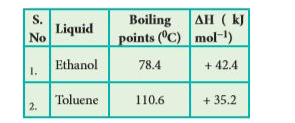Complete Solutions to EVALUATION of chapter THERMODYNAMICS of Class 11 book with complete answers and questions
| Class 11 | CHEMISTRY |
| Chapter | THERMODYNAMICS |
| TAMILNADU GOVT | EVALUATION |
| Number Of Questions | 19 |
| Academic Year | 2023-24 |
Calculate the work done when 2 moles of an ideal gas expands reversibly and isothermally from a volume of 500 ml to a volume of 2 L at `25^(@)C` and normal pressure.
View SolutionIn a constant volume calorimeter, 3.5 g of a gas with molecular weight 28 was burnt in excess oxygen at 298 K. The temperature of the calorimeter was found to increase from 298 K to 298.45 K due to the combustion process. Given that the calorimeter constant is `2.5 kJ K^(-1)`. Calculate the enthalpy of combustion of the gas in `kJ" mol"^(-1)`.
View SolutionCalculate the entropy change in the system, and surroundings, and the total entropy change in the universe during a process in which 245 J of heat flow out of the system at `77^(@)C` to the surrounding at `33^(@)C`.
View Solution1 mole of an ideal gas, maintained at 4.1 atm and at a certain temperature, absorbs heat 3710J and expands to 2 litres. Calculate the entropy change in expansion process.
View Solution30.4 kJ is required to melt one mole of sodium chloride. The entropy change during melting is `28.4 JK^(-1)" mol"^(-1)`. Calculate the melting point of sodium chloride.
View SolutionCalculate the standard heat of formation of propane, if its heat of combustion is `-2220.2" kJ mol"^(-1)`. the heats of formation of `CO_(2)(g) and H_(2)O(l)" are "-393.5 and -285.8" kJ mol"^(-1)` respectively.
View SolutionYou are given normal boiling points and standard enthalpies of vapourisation. Calculate the entropy of vapourisation of liquids listed below.

View SolutionFor the reaction `Ag_(2)O(S) rarr 2Ag(s) +(1)/(2) O_(2) (g) : Delta H = 30.56" kJ mol"^(-1) and Delta S =6.66 JK^(-1)" mol"^(-1)` (at 1 atm). Calculate the temperature at which `Delta G` is equal to zero. Also predict the direction of the reaction (i) at this temperature and (ii) below this temperature.
View SolutionWhat is the equilibrium constant Keq for the following reaction at 400K
`2NOCl (g) hArr 2NO(g) + Cl_(2) (g)`,
given that `Delta H^(0) =77.2" kJ mol"^(-1), and Delta S^(0) =122 JK^(-1)" mol"^(-1)`.
View SolutionCyanamide `(NH_(2)CN)` is completely burnt in excess oxygen in a bomb calorimeter, `Delta U` was found to be `-742.4" kJ mol"^(-1)`, calculate the enthalpy change of the reaction at `298 K. NH_(2) CN(s) +(3)/(2) O_(2)(g) to N_(2)(g) +CO_(2)(g) +H_(2)O(l) Delta H=`?
View SolutionCalculate the enthalpy of hydrogenation of ethylene from the following data. Bond energies of C `− H, C − C , C = C and H − H` are `414, 347, 618 and 435 kJ mol −1`.
View SolutionCalculate the lattice energy of `CaCl_(2)` from the given data
`Ca(s) +Cl_(2)(g) rarr CaCl_(2)(s) Delta H_(f)^(0) =-795" kJ mol"^(-1)`
`{:("Atomisation ": Ca(s) rarr Ca(g)" "Delta_(1)^(0)=+121" kJ mol"^(-1)),("Ionisation ": Ca(g) to Ca^(2+)(g) +2e^(-)" "Delta H_(2)^(0) =+2422" kJ mol"^(-1)), ("Dissociation ": Cl_(2)(g) to 2Cl(g)" "Delta H_(3)^(0) =+242.8" kJ mol"^(-1)),("Electron affinity": Cl(g) +e^(-) to Cl^(-)(g)" "Delta H_(4)^(0)=-355" kJ mol"^(-1)):}`
View SolutionCalculate the enthalpy change for the reaction `Fe_(2)O_(3) + 3CO to 2Fe + 3CO_(2)` from the following data.
`2Fe+(3)/(2)O_(2) to fe_(2)O_(3), Delta H =-741 kJ`
`C+(1)/(2) O_(2) to CO, Delta H =-137 kJ`
`C+ O_(2) to CO_(2), Delta H =-394.5 kJ`
View SolutionWhen 1-pentyne (A) is treated with 4N alcoholic KOH at `175^(@)C`, it is converted slowly into an equilibrium mixture of 1.3% 1-pentyne(A) , 95.2% 2-pentyne(B) and 3.5% of 1,2 pentadiene (C) the equilibrium was maintained at `175^(@)C`, calculate `Delta G_(0)` for the following equilibria.
`{:(B hArr A" "Delta G_(1)^(0)=?),(B hArr C" "Delta G_(2)^(0)=?):}`
View SolutionAt `33K, N_(2)O_(4)` is fifty percent dissociated. Calculate the standard free energy change at this temperature and at one atmosphere.
View SolutionThe standard enthalpies of formation of `SO_(2) and SO_(3)` are `-297" kJ mol"^(-1) and -396" kJ mol"^(-1)` respectively. Calculate the standard enthalpy of reaction for the reaction: `SO_(2)+(1)/(2) O_(2) to SO_(3)`
View SolutionFor the reaction at 298 K : `2A+B to C`
`Delta H = 400" J mol"^(-1), Delta S =0.2 JK^(-1)" mol"^(-1)` Determine the temperature at which the reaction would be spontaneous.
View SolutionFind out the value of equilibrium constant for the following reaction at `298K, 2 NH_(3)(g) + CO_(2) (g) hArr NH_(2)CONH_(2) (aq) + H_(2)O (l)` Standard Gibbs energy change, `Delta G_(r)^(0)` at the given temperature is `-13.6" kJ mol"^(-1)`.
View SolutionA gas mixture of 3.67 lit of ethylene and methane on complete combustion at `25^(@)C` and at 1 atm pressure produce 6.11 lit of carbondioxide. Find out the amount of heat evolved in kJ, during this combustion. `(Delta H_(C) (CH_(4))=-890" kJ mol"^(-1) and (Delta H_(C) (C_(2)H_(4)) =-1423" kJ mol"^(-1)`
View Solution
EVALUATION questions and complete solutions for chapter THERMODYNAMICS of FULL MARKS CHEMISTRY(TAMIL) of Class 11